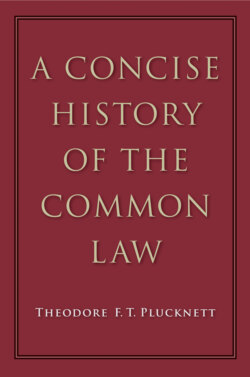Читать книгу A Concise History of the Common Law - Theodore F. T. Plucknett - Страница 156
На сайте Литреса книга снята с продажи.
THE KING’S BENCH
ОглавлениеThe fact that these special arrangements had to be made for the review of judgments given in the King’s Bench will show that that court was enjoying unusually good business during the sixteenth century. The preamble to the earlier of the two statutes cited explains that the new court shall hear writs of error brought on “actions or suits of debt, detinue, covenant, account, action on the case, ejectione firmæ, and trespass” in the King’s Bench. These seven actions properly belonged to the Court of Common Pleas. Trespass (and ejectione firmæ resembled trespass) seems also to have been part of the original jurisdiction of the King’s Bench, but during the middle ages the only trespasses usually brought in the King’s Bench were those of unusual violence or importance.2 Most of this jurisdiction, therefore, had been acquired at a later period, and by somewhat devious means.
We have already mentioned the conflict of the King’s Bench with the Exchequer and with the Common Pleas in the fourteenth century;3 in the fifteenth century a second effort brought the King’s Bench once more into competition, if not into conflict, with the Common Pleas. The device employed in order to acquire the wide jurisdiction mentioned in Elizabeth’s statute4 of 1585 was fairly commonly used in the reign of Henry VI and was in constant use throughout the Tudor period. A bill of Middlesex made the defendant actually or fictitiously a prisoner in the custody of the marshall of the court’s marshalsea. This done, the court could entertain any sort of action against him since he was already within the jurisdiction of the court—a principle, moreover, which most courts professed. In such cases the proceedings were by bill instead of by original writ. Before the end of the century means were found5 whereby the defendant could be really arrested if he would not voluntarily admit that he was technically in the custody of the marshall, and so the new procedure served as the complete equivalent of an original writ. Throughout the sixteenth century the court enjoyed this usurped jurisdiction, with curious results. The competition between King’s Bench and Common Pleas was sometimes not merely a matter of offering procedural advantages, but sometimes even in offering better substantive law. Thus in at least one matter, which we shall refer to later,1 the two courts deliberately competed by offering two different rules of law for litigants to choose from, and in the end it was the more enlightened rule which prevailed.
